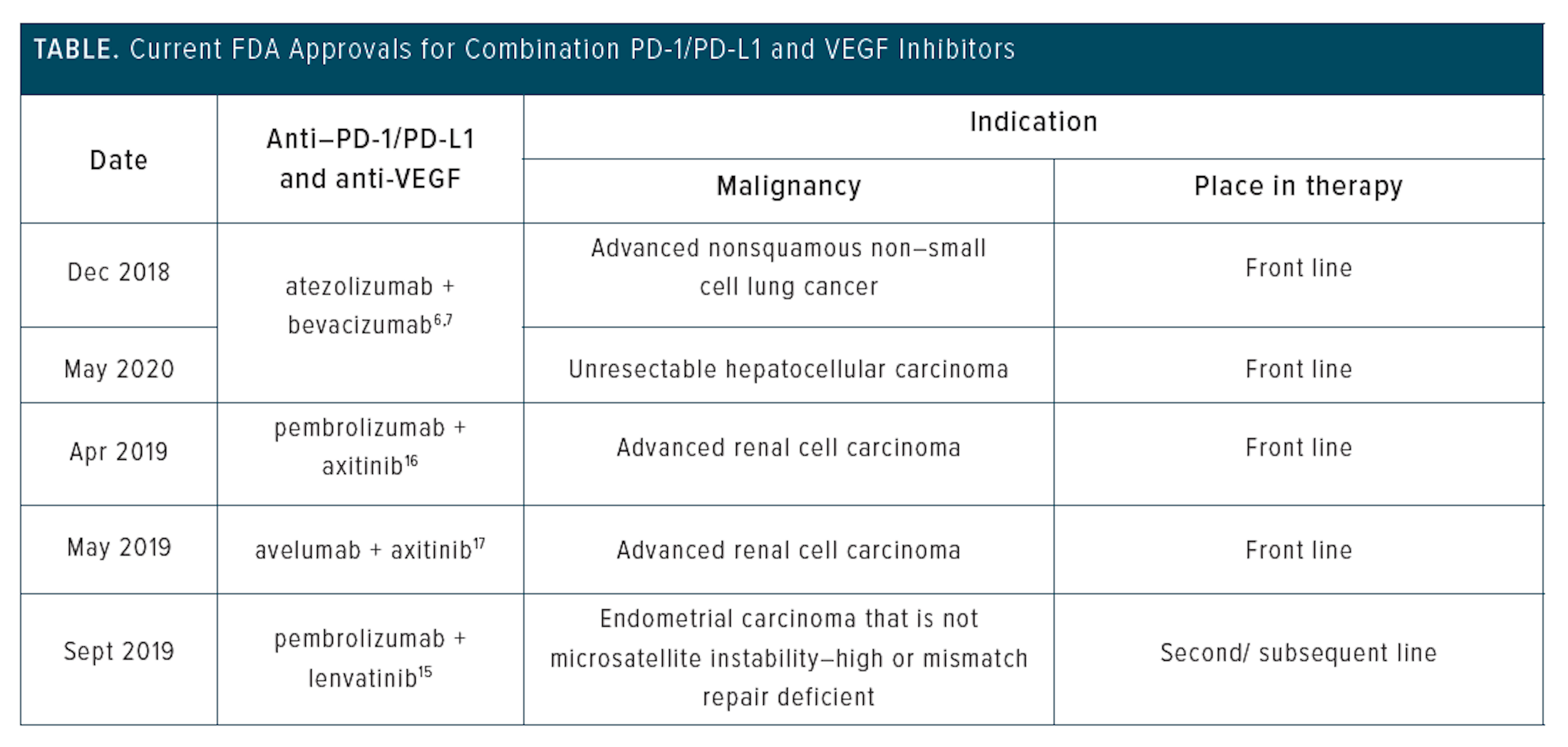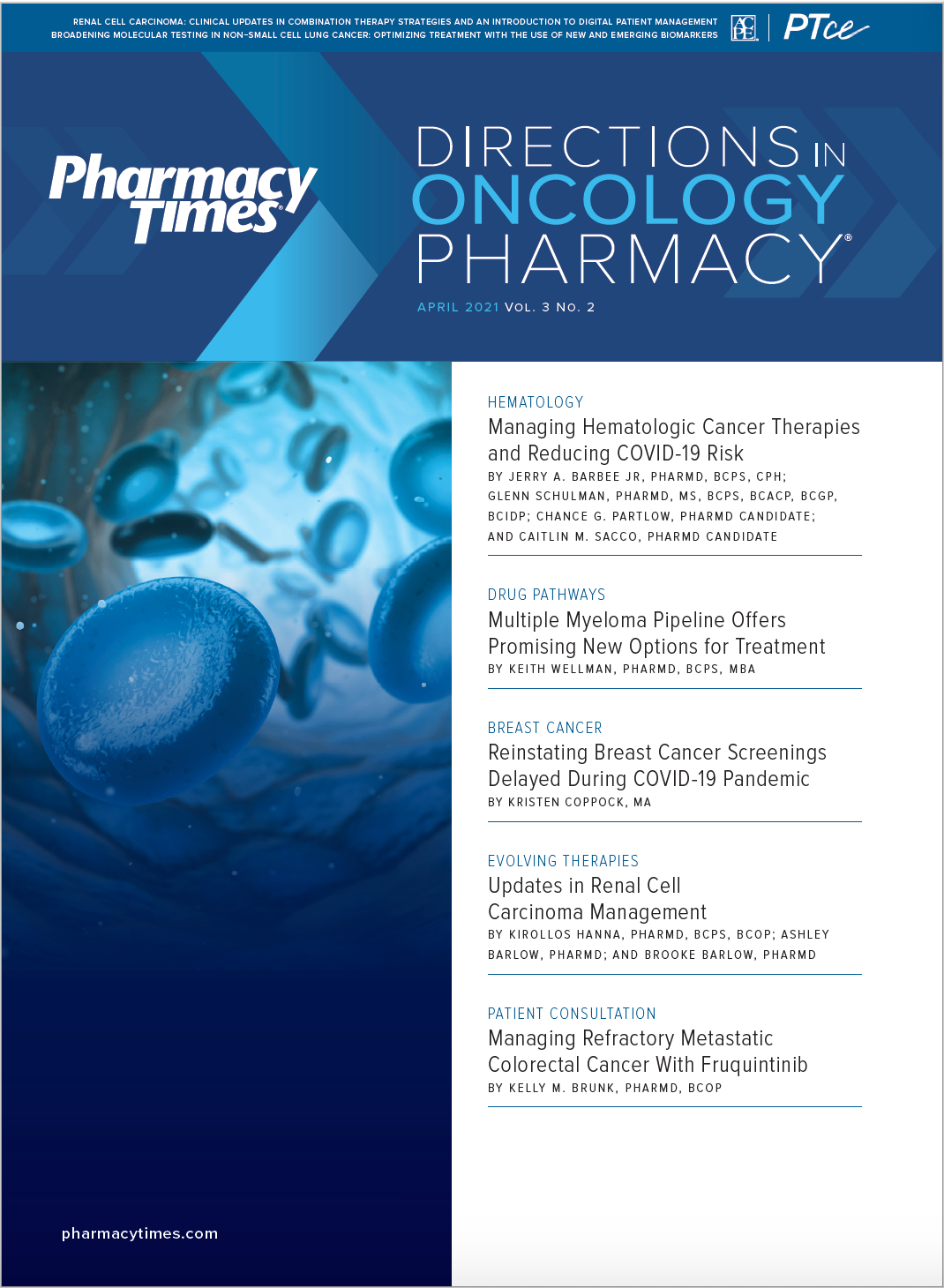Publication
Article
Pharmacy Practice in Focus: Oncology
Use of PD-1/PD-L1 and VEGF Inhibition Combination Is Expanding
Author(s):
The relatively new combination of PD-1/PD-L1 inhibitors with VEGF inhibitors represents a promising option for patients with various malignancies.
Programmed cell death protein-1 (PD-1)/programmed cell death ligand 1 (PD-L1) inhibitors have transformed the treatment of cancer since pembrolizumab (Keytruda; Merck Sharp & Dohme Corp) first entered the market in 2014 for advanced melanoma.1,2
Nivolumab (Opdivo; Bristol-Myers Squibb Company) joined pembrolizumab with the same FDA approval several months later, and thus began the surge of indications for anti–PD-1/PD-L1 monoclonal antibodies for the treatment of various malignancies that continues to this day.3
Anti–vascular endothelial growth factor (VEGF) therapy is used to treat a wide variety of malignancies, in the front-line setting and beyond.4 Sorafenib (Nexavar; Bayer HealthCare Pharmaceuticals Inc) was the first VEGF tyrosine kinase inhibitor (TKI), approved in 2005 for the treatment of advanced renal cell carcinoma.5 After this approval, anti-VEGF therapies began expanding into other areas in cancer care in a similar manner to PD-1/PD-L1 inhibitors.
Results from clinical trials studying the combination of PD-1/PD-L1 and VEGF inhibitors for the treatment of various malignancies began to be published and FDA approvals followed shortly thereafter. The first approved combination of anti–PD-1/PD-L1 and anti-VEGF therapy, atezolizumab (Tecentriq; Genentech, Inc) and bevacizumab (Avastin; Genentech, Inc), in December 2018, was for the treatment of metastatic nonsquamous non–small cell lung cancer.6 The same combination was also approved for the treatment of hepatocellular carcinoma in May 2020.7
Pharmacology
Anti–PD-1/PD-L1 monoclonal antibodies, also termed checkpoint inhibitors, are referred to generally as immunotherapy, and more recently as immuno-oncology. These agents exert anticancer activity by binding PD-1 or PD-L1 that is present on the surface of tumor cells and CD8-positive T cells, thus blocking the interaction. When PD-1 and PD-L1 bind normally, it causes downregulation of the immune system. Therefore, the prevention of these inhibitory signals, in effect, stimulates the immune system to target tumors. Whether the agent is an anti–PD-1 or anti–PD-L1 monoclonal antibody, the effect is the same.8 At present, FDA-approved anti–PD-1 monoclonal antibodies include pembrolizumab, nivolumab, and cemiplimab (Libtayo; Regeneron Pharmaceuticals, Inc), and anti–PD-L1 monoclonal antibodies include atezolizumab, avelumab (Bavencio; EMD Serono), and durvalumab (Imfinzi; AstraZeneca Pharmaceuticals LP).9
Anti-VEGF therapies are subdivided into 3 subclasses: orally administered TKIs, intravenous (IV) monoclonal antibodies, and an IV recombinant fusion protein. The TKIs sorafenib, sunitinib (Sutent; Pfizer), pazopanib (Votrient; Novartis Pharmaceuticals Corporation), lenvatinib (Lenvima; Eisai Inc), regorafenib (Stivarga; Bayer HealthCare Pharmaceuticals Inc), cabozantinib (Cabometyx; Exelixis, Inc), axitinib (Inlyta; Pfizer), and vandetanib (Caprelsa; AstraZeneca Pharmaceuticals LP) are multikinase inhibitors, as they bind and antagonize several types of receptor tyrosine kinases in addition to VEGF.10 PDGFRs, FGFRs, and KIT inhibitors also lend their use in diverse malignancies according to driver mutations in these receptors.10
The anti-VEGF monoclonal antibodies are inherently more specific than the TKIs; those on the market include bevacizumab and ramucirumab (Cyramza; Eli Lilly and Company).9 Bevacizumab binds to circulating VEGF type A, preventing it from binding a VEGF receptor. Ramucirumab, on the other hand, binds to the extracellular portion of the VEGF receptor, thereby blocking the binding of VEGF and causing a similar effect.10
Lastly, ziv-aflibercept (Zaltrap; Sanofi-Aventis US LLC) is a recombinant fusion protein with limited indications; it acts as a decoy receptor for VEGF type A and B.11
Combination Therapy
Previous research results have elucidated the role of tumor-produced VEGF in solid tumor angiogenesis in addition to immune system downregulation, which allows for tumor growth and immune system escape.4,12 Although the antiangiogenetic effects of VEGF inhibitors are partly responsible for the disease responses observed, the inhibition of immune system downregulation caused by tumor-produced VEGF is another pharmacodynamic mechanism that can be exploited to achieve better outcomes.4
Considering the anti-immunosuppressive effects of VEGF inhibitors, it stands to reason that synergy is seen when VEGF inhibitors are combined with PD-1/PD-L1 inhibitors.13 Therefore, investigators and drug manufacturers are exploring this combination in several malignancies in which PD-1/PD-L1 inhibitors and VEGF inhibitors currently play a role in treatment, exclusive of one another.
The fundamental approach taken in combination chemotherapy is such that the individual agents in a regimen have differing dose-limiting toxicities and mechanisms. In this manner, multiple agents can be combined with differing adverse effects so that toxicities are not additive. Rather, toxicities that are separated over a range of types can be individually managed while the additive or even synergistic efficacy of all the agents is maintained.14
The strategy of combination therapy began with cytotoxic chemotherapy regimens and has since evolved into targeted and monoclonal antibody therapies, with PD-1/PD-L1 and VEGF inhibitors representing a relatively novel pairing in cancer care. The Table shows a summary of PD-1/PD-L1 and VEGF inhibitor combinations currently approved by the FDA.

Patient Eligibility
Anti–PD-1/PD-L1 monoclonal antibodies are often approved with minimum requirements of PD-L1 expression upon tumor staining, which is measured in combined positivity score (CPS) or tumor proportion score (TPS). Tumors with microsatellite instability–high (MSI-H) status or mismatch repair deficiency (dMMR) may be another condition often attached to the indication for anti–PD-1/PD-L1 monoclonal antibodies. Notably, only 1 indication for a PD-1/PD-L1 and VEGF inhibitor combination has 1 of these conditions: patients with advanced endometrial cancer must not have MSI-H or dMMR disease status to qualify for treatment with pembrolizumab and lenvatinib.15 No other PD-1/PD-L1 and VEGF inhibitor combinations have these requirements included with their FDA approval, affording more opportunities for patients to benefit from therapy.
Dozens of clinical trials evaluating PD-1/PD-L1 and VEGF inhibitor combinations are listed on ClinicalTrials.gov, and most are actively recruiting. They are assessing combinations along with the addition of chemotherapy and other targeted therapies. Given the number of trials in process and the results previously seen, it is likely that more approvals of this combination are on the horizon.
Conclusions
PD-1/PD-L1 inhibitors continue to change the cancer treatment landscape, and the relatively new combination with VEGF inhibitors represents a promising option for patients with various malignancies. Most likely, the trend of combined PD-1/PD-L1 and VEGF inhibition therapy will keep expanding into areas in which PD-1/PD-L1 and VEGF inhibitors are already being used.
VINCENT J CASCONE, PHARMD, BCOP, is a clinical oncology pharmacist at the University of Kansas Health System in Kansas City.
REFERENCES
- Robert C. A decade of immune-checkpoint inhibitors in cancer therapy. Nat Commun. 2020;11(1):3801. doi:10.1038/s41467-020-17670-y
- Dangi-Garimella S. First PD-1 inhibitor approved for melanoma. AJMC. September 19, 2014. Accessed February 10, 2021. https://www.ajmc.com/view/first-pd-1-inhibitor-approved-for-melanoma
- Bristol-Myers Squibb receives accelerated approval of Opdivo (nivolumab) from the US Food and Drug Administration. News release. Bristol-Myers Squibb. December 22, 2014. Accessed February 10, 2021. https://news.bms.com/news/details/2014/Bristol-Myers-Squibb-Receives-Accelerated-Approval-of-Opdivo-nivolumab-from-the-US-Food-and-Drug-Administration/default.aspx
- Fukumura D, Kloepper J, Amoozgar Z, Duda DG, Jain RK. Enhancing cancer immunotherapy using antiangiogenics: opportunities and challenges. Nat Rev Clin Oncol. 2018;15(5):325-340. doi:10.1038/nrclinonc.2018.29
- Qin S, Li A, Yi M, Yu S, Zhang M, Wu K. Recent advances on anti-angiogenesis receptor tyrosine kinase inhibitors in cancer therapy. J Hematol Oncol. 2019;12(1):27. doi:10.1186/s13045-019-0718-5
- FDA approves atezolizumab with chemotherapy and bevacizumab for first-line treatment of metastatic non-squamous NSCLC. FDA. Updated December 14, 2018. Accessed February 10, 2021. https://www.fda.gov/drugs/fda-approves-atezolizumabchemotherapy-and-bevacizumab-first-line-treatment-metastatic-non-squamous
- FDA approves atezolizumab plus bevacizumab for unresectable hepatocellular carcinoma. FDA. Updated June 1, 2020. Accessed February 10, 2021. https://www.fda.gov/drugs/drug-approvals-and-databases/fda-approves-atezolizumab-plus-bevacizumab-unresectable-hepatocellular-carcinoma
- Sunshine J, Taube JM. PD-1/PD-L1 inhibitors. Curr Opin Pharmacol. 2015;23:32-38. doi:10.1016/j.coph.2015.05.011
- Drugs@FDA: FDA-Approved Drugs. FDA. Accessed 12/10/2020. https://www.accessdata.fda.gov/scripts/cder/daf/
- Zirlik K, Duyster J. Anti-angiogenics: current situation and future perspectives. Oncol Res Treat. 2018;41(4):166-171. doi:10.1159/000488087
- Zaltrap. Prescribing information. Sanofi-Aventis U.S. LLC; 2020.
- Hato T, Zhu AX, Duda DG. Rationally combining anti-VEGF therapy with checkpoint inhibitors in hepatocellular carcinoma. Immunotherapy. 2016;8(3):299-313. doi:10.2217/imt.15.126
- Yi M, Jiao D, Qin, S, Chu Q, Wu K, Li A. Synergistic effect of immune checkpoint blockade and anti-angiogenesis in cancer treatment. Mol Cancer. 2019;18(1):60. doi:10.1186/s12943-019-0974-6
- Frei E III, Eder JP. Principles of Dose, Schedule, and Combination Therapy In: Kufe DW, Pollock RE, Weichselbaum RR, et al, eds. Holland-Frei Cancer Medicine. 6th ed. BC Decker; 2003.
- Simultaneous review decisions for pembrolizumab plus lenvatinib in Australia, Canada and US. FDA. Updated September 17, 2019. Accessed February 10, 2021. https://www.fda.gov/drugs/resources-information-approved-drugs/simultaneous-review-decisions-pembrolizumab-plus-lenvatinib-australia-canada-and-us
- FDA approves pembrolizumab plus axitinib for advanced renal cell carcinoma. FDA. Updated April 22, 2019. Accessed February 10, 2021. https://www.fda.gov/drugs/drug-approvals-and-databases/fda-approves-pembrolizumab-plus-axitinib-advanced-renal-cell-carcinoma
- FDA approves avelumab plus axitinib for renal cell carcinoma. FDA. Updated May 15, 2019. Accessed February 10, 2021. https://www.fda.gov/drugs/resources-information-approved-drugs/fda-approves-avelumab-plus-axitinib-renal-cell-carcinoma







